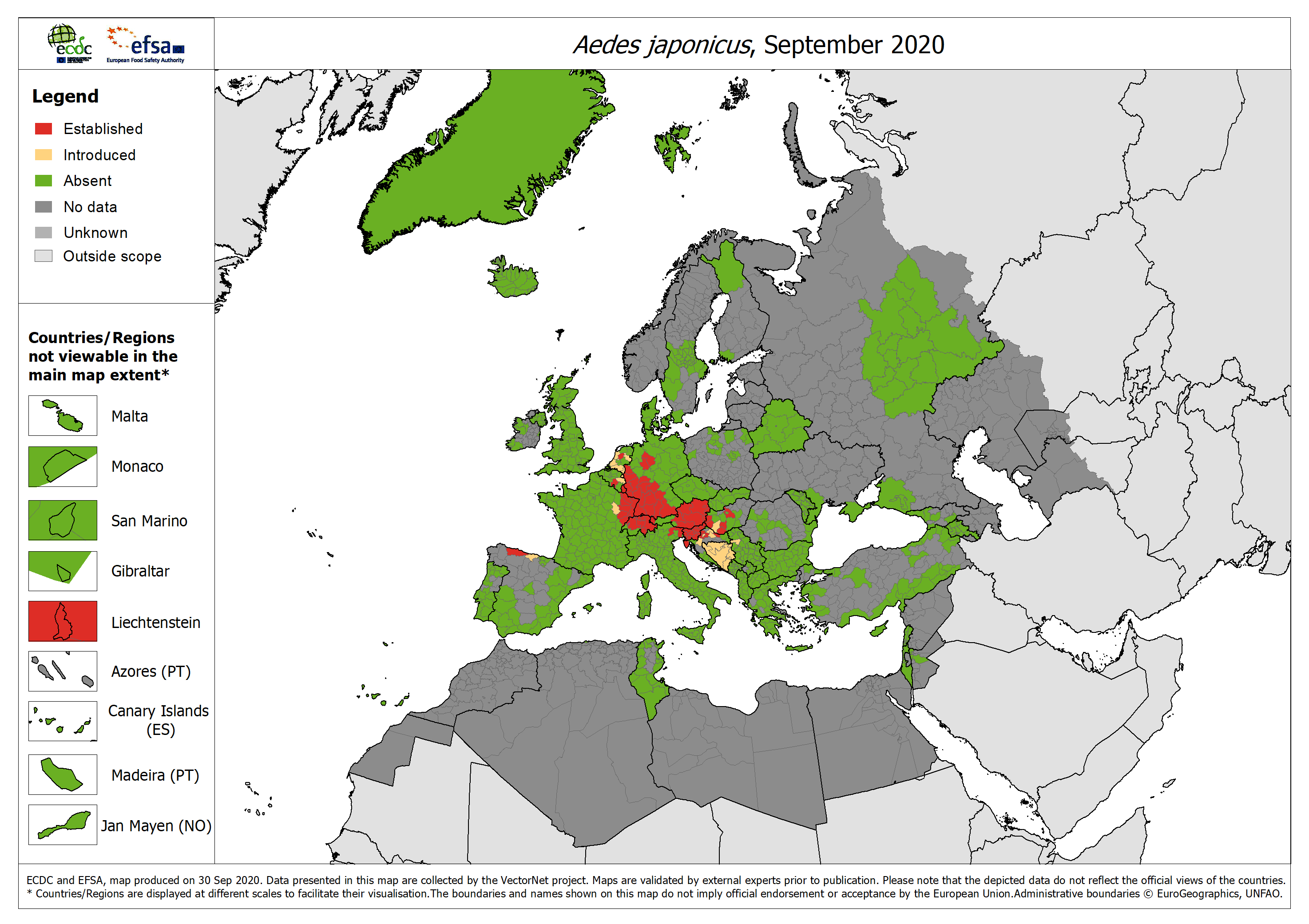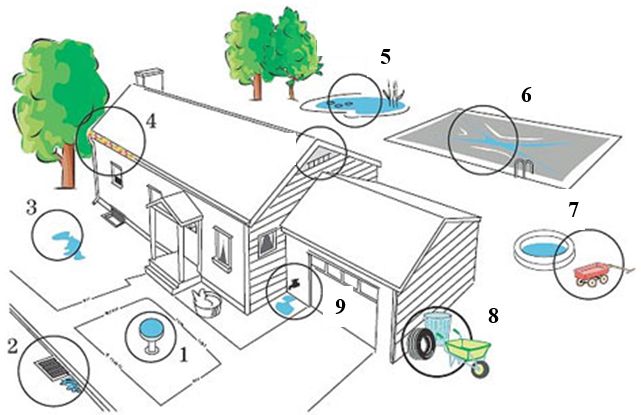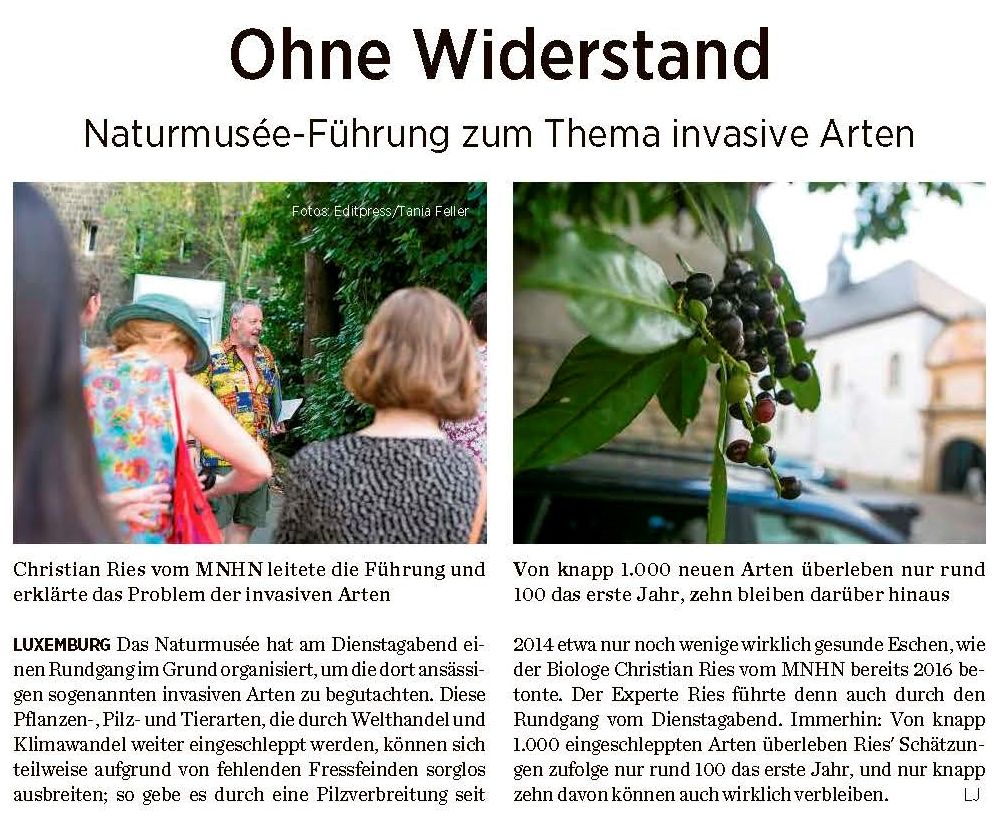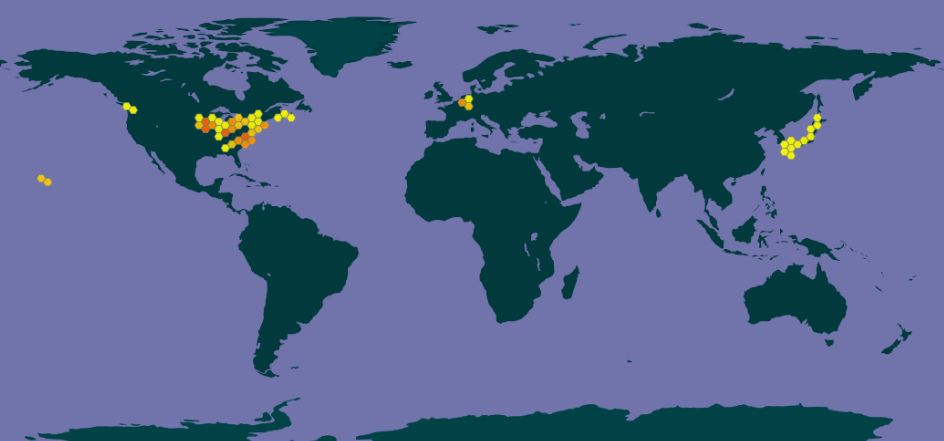Synonyms: Ochlerotatus japonicus, Hulecoeteomyia japonica
 |
East Asian bush or rock pool mosquito |
Status LU: established. 1st record: 2018. |
 |
Japanesch Iergermustik |
Status Eur.: established. |
 |
n/a |
RA: ISEIA: C2. Harmonia+: 0,34. |
 |
Asiatische Buschmücke |
Wikipedia:     | Wikispecies: n/a (2020) | Wikispecies: n/a (2020) |
 |
Aziatische bosmug |
Back to the list of invertebrates |
Brief description
 Aedes japonicus (Theobald, 1901), commonly known as the Asian bush mosquito or the Asian rock pool mosquito, has four known subspecies Ae. j. japonicus, Ae. j. shintienensis, Ae. j. yaeyamensis, and Ae. j. amamiensus. They are competent arbovirus vectors known to transmit the West Nile virus as well as Japanese and St. Louis encephalitis. They are listed as an invasive species by the Global Invasive Species Database.
Aedes japonicus (Theobald, 1901), commonly known as the Asian bush mosquito or the Asian rock pool mosquito, has four known subspecies Ae. j. japonicus, Ae. j. shintienensis, Ae. j. yaeyamensis, and Ae. j. amamiensus. They are competent arbovirus vectors known to transmit the West Nile virus as well as Japanese and St. Louis encephalitis. They are listed as an invasive species by the Global Invasive Species Database.
Adults live in forested areas and are day biters, but are apparently reluctant to bite humans. In the laboratory, they feed on chicks and mice but not on reptiles or amphibians. Larvae occur in a wide variety of natural and artificial water retainers such as tree holes and rock holes, usually preferring shaded places and water rich in organic matter. They are found from early spring to early autumn in their native habitat of Central Japan. They overwinter as eggs in cooler regions and larvae in warmer regions. Adults have a distinctive bronze-colored, lyre-shaped pattern on the scutum, and larvae have a linear arrangement of branched frontal setae and a strongly spiculated anal saddle (Wikipedia contributors 2020).
Advice for the population
Please refer to the Internet page https://mosquitoes.lu/dealing-with-mosquitoes/ for detailed information in 5 languages (



 ) on how to deal with mosquitoes near your home.
) on how to deal with mosquitoes near your home.
Status and distribution in Luxembourg
3 female imagoes of
Aedes japonicus (Syn.:
Hulecoeteomyia japonica) were captured on 4th July 2018 in Stolzembourg, Oesling. Field exploration on 1st and 2nd August showed the East Asian bush mosquito is also present in Bivels, Vianden, Wahlhausen and Gemünd (D). Further field studies in August and October 2018 revealed the presence of a large population of
Aedes japonicus, detected in 16 sites distributed over 12 localities, 12 municipalities, 7 cantons and 3 districts. The colonised area can be estimated to date to cover at least 550 km², located in the east of the Grand Duchy, from the valley of the Our in the north to Ernster in the south, and as far as Kautenbach and Ettelbruck in the west. The mosquito was not detected in neighbouring Belgium (Clairefontaine and Ouren) but it was in Germany, where it has been present for several years in Rhineland-Palatinate and from where it has certainly migrated to the Grand Duchy. We also detected it in the French border town of Contz-les-Bains, which suggests that the mosquito is probably present, although not detected to date, in the region bordering the Moselle, from Manternach to the French border (Schaffner 2018).

Distribution of the mosquito Aedes japonicus known as of 10 October 2018, for Luxembourg and the neighbouring regions of Germany, Belgium and France. Purple: proven presence; Purple with star: data from the German surveillance network; Green: undetected presence (Schaffner 2018).
The species is established in the Province of Namur (Belgium), in North Rhine-Westphalia, Rhineland-Palatinate and Hesse (Germany), and in Bas-Rhin, Haut-Rhin, Vosges (France).
Risk assessment
ISEIA protocol
C2 (3+2+2+1), assessment updated on 13 August 2018 by M. Pfeiffenschneider & C. Ries. Former assessment under it’s synonym Hulecoeteomyia japonica: C0 (2+1+1+1) (Ries et al. 2017: 68).
Harmonia+ protocol
Overall risk score 0,34 = (Overall Invasion score 0,67 x Overall Impact score 0,50) (Schaffner & Ries 2019: 178).
0,67


Invasion
0,50


Impact
0,34


Risk
Initial importations and spread in Europe
Source: https://ecdc.europa.eu/en/disease-vectors/facts/mosquito-factsheets/aedes-japonicus [accessed July 31 2018]
Aedes japonicus was first reported in Europe in 2000 when it was detected in Normandy (Orne) in northern France, where it was later eliminated. It was then reported in 2002 in Belgium at a tyre depot and presence as adults and larvae was confirmed in 2007 and 2008. It was most likely introduced through the trade of tyres and the population was thought to be established at the company site but does not appear to be spreading. It was detected in Switzerland in 2008 following reports of a biting nuisance and subsequent surveys revealed a 1,400 km colonised zone including an area in Germany. This was the first detection of invasive mosquitoes spreading in central Europe. No obvious route of introduction was identified in this study but it is suspected that the species has been present here for some time. Adult Ae. japonicus were then found in southern Germany during 2011, following intensified surveillance. This resulted in surveillance expanding to cover the entire federal state of Baden-Württemberg where a reduction in the colonised areas compared to 2010 was reported (possibly due to a dry spring during 2011). However, a large, newly infested area was also reported from the city of Stuttgart to the Swabian Mountains. Entomological surveys carried out during 2012 in North Rhine-Westphalia also revealed the presence of an established population in the west of the country. Aedes japonicus were then reported further north in southern Lower Saxony and northeastern North Rhine-Westphalia during spring 2013. It was detected in 2012 and 2013 in Lelystad, the Netherlands.

Source: The map shows the current known distribution of Aedes japonicus in Europe at at ‘regional’ administrative level (NUTS3), as of September 2020 (ECDC & EFSA, 2020).
It is suggested that Aedes japonicus may expand beyond its current geographical distribution but there is still a lack of information available on this invasive mosquito species.
Worldwide distribution
References
- ECDC & EFSA, 2020. European Centre for Disease Prevention and Control and European Food Safety Authority. Mosquito maps [internet]. Stockholm: ECDC; 2020. Available from: https://ecdc.europa.eu/en/disease-vectors/surveillance-and-disease-data/mosquito-maps
- Ganser, J., 2020. Tigermücke im Anflug. Exotische Stechfliegen finden vermehrt den Weg nach Luxemburg. Das muss aber kein Grund zur Panik sein. Luxemburger Wort online 2020-09-21. URL: https://www.wort.lu/de/lokales/tigermuecke-im-anflug-5f68bdc4de135b9236d06c07
- GBIF, 2019. Aedes japonicus (Theobald, 1901) in GBIF Secretariat (2019). GBIF Backbone Taxonomy. Checklist dataset https://doi.org/10.15468/39omei [accessed 2020-04-08]
- Ministère de la Santé, 2018. Première apparition du moustique japonais « Aedes japonicus » au Luxembourg. Communiqué de presse du 1er août 2018. [PDF 40 KB]
- MNHNL, iNaturalist & GBIF, 2020. Aedes japonicus (Theobald, 1901) in MNHNL-mdata, online portal combining species observation from Recorder-Lux, iNaturalist and GBIF. National Museum of Natural History, Luxembourg. URL: https://mdata.mnhn.lu [accessed 2020-04-08]
- Ries, C., A. Arendt, C. Braunert, S. Christian, A. Dohet, A. Frantz, G. Geimer, M. Hellers, J. A. Massard, X. Mestdagh, R. Proess, N. Schneider & M. Pfeiffenschneider, 2017. Environmental impact assessment and black, watch and alert list classification after the ISEIA Protocol of invertebrates in Luxembourg. Bull. Soc. Nat. luxemb. 119: 63-70. [PDF 360 KB]
- Schaffner, F., 2018. Le moustique Aedes japonicus au Luxembourg : État des connaissances au 10 octobre 2018. Rapport de mission pour la Direction de la santé, grand-duché de Luxembourg. 14 p. [PDF 1.4 MB]
- Schaffner, F. & C. Ries, 2019. First evidence and distribution of the invasive alien mosquito Aedes japonicus (Theobald, 1901) in Luxembourg. Bull. Soc. Nat. luxemb. 121: 169-183. [PDF 8,94 MB]
- Wikipedia contributors, 2020. ‘Aedes japonicus’ in Wikipedia, The Free Encyclopedia. URL: https://en.wikipedia.org/w/index.php?title=Aedes_japonicus&oldid=940631744 [accessed 2020.04.08]
Page content last updated on 2024-07-25. Last proofread by Caroline Grounds on 2019-12-04.





















